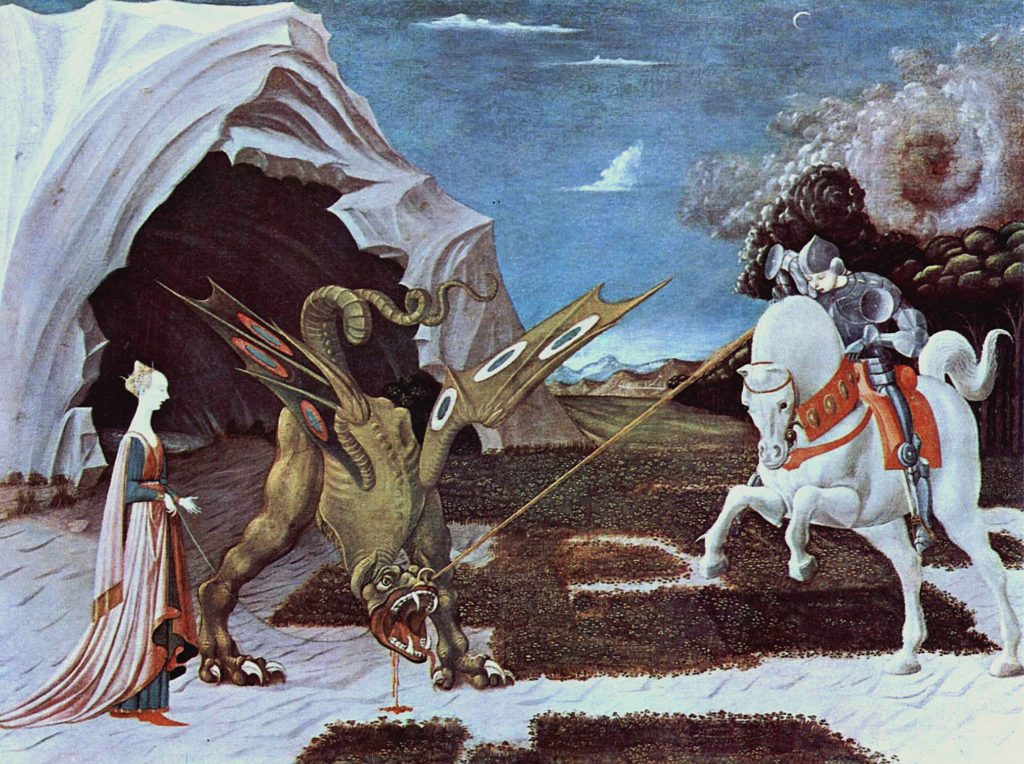
Monday
In Friday’s NCTE talk, I quoted Neil Gaiman’s well-known observation about fairy tales and dragons. Learning that it was inspired by G.K. Chesterton, I have tracked down the original passage and reflect upon it today.
Neil Gaiman’s quote applies nicely to works like Beowulf and The Odyssey as well as to fairy tales:
Fairy tales are more than true: not because they tell us that dragons exist, but because they tell us that dragons can be beaten.
Chesterton wrote:
Fairy tales do not give the child his first idea of bogey. What fairy tales give the child is his first clear idea of the possible defeat of bogey. The baby has known the dragon intimately ever since he had an imagination. What the fairy tale provides for him is a St. George to kill the dragon.
Chesterton’s observation, appearing in a collection of informal essays called Tremendous Trifles (1909), comes to the defense of fairy tales:
[A] lady has written me an earnest letter saying that fairy tales ought not to be taught to children even if they are true. She says that it is cruel to tell children fairy tales, because it frightens them.
Anticipating Bruno Bettleheim, who in The Uses of Enchantment lacerated Disney for sugarcoating the Grimm Brothers, Chesterton says that children have darker imaginations than the letter writer is willing to admit. He continues,
You might just as well say that it is cruel to give girls sentimental novels because it makes them cry. All this kind of talk is based on that complete forgetting of what a child is like which has been the firm foundation of so many educational schemes. If you keep bogies and goblins away from children they would make them up for themselves. One small child in the dark can invent more hells than Swedenborg. One small child can imagine monsters too big and black to get into any picture, and give them names too unearthly and cacophonous to have occurred in the cries of any lunatic. The child, to begin with, commonly likes horrors, and he continues to indulge in them even when he does not like them. There is just as much difficulty in saying exactly where pure pain begins in his case, as there is in ours when we walk of our own free will into the torture-chamber of a great tragedy. The fear does not come from fairy tales; the fear comes from the universe of the soul.
Where does the fear come from? From the world, which is “a very alarming place.” There’s some racism in Chesterton’s subsequent argument but his observation about children is sound:
The timidity of the child or the savage is entirely reasonable; they are alarmed at this world, because this world is a very alarming place. They dislike being alone because it is verily and indeed an awful idea to be alone. Barbarians fear the unknown for the same reason that Agnostics worship it—because it is a fact. Fairy tales, then, are not responsible for producing in children fear, or any of the shapes of fear; fairy tales do not give the child the idea of the evil or the ugly; that is in the child already, because it is in the world already. Fairy tales do not give the child his first idea of bogey.
Then we get the observation that Gaiman embraces:
What fairy tales give the child is his first clear idea of the possible defeat of bogey. The baby has known the dragon intimately ever since he had an imagination. What the fairy tale provides for him is a St. George to kill the dragon.
Exactly what the fairy tale does is this: it accustoms him for a series of clear pictures to the idea that these limitless terrors had a limit, that these shapeless enemies have enemies in the knights of God, that there is something in the universe more mystical than darkness, and stronger than strong fear.
Attacking overly rational agnostics as well as fussy ladies, Chesterton says that a child needs fantasy heroes:
At the four corners of a child’s bed stand Perseus and Roland, Sigurd and St. George. If you withdraw the guard of heroes you are not making him rational; you are only leaving him to fight the devils alone.
The attacks on fantasy literature that Chesterton encountered in 1909 didn’t disappear as the century wore on. To cite one example, some parents attacked Maurice Sendak’s Where the Wild Things Are when it appeared it frankly acknowledged child anger. Yet the book remains a consistent children’s favorite, in large part because Max masters the monsters. Essentially, he gives therapeutic vent to his anger, after which he can reconcile with his loving mother, who has a warm meal waiting for him.
In Chesterton’s framing, the story assures him that seemingly limitless dark emotions in fact have a limit. And can be conquered.

